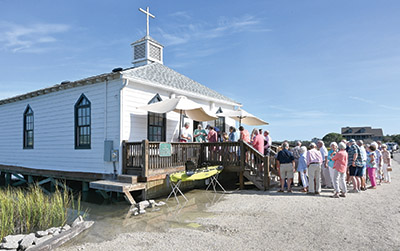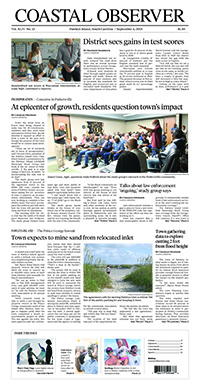Pawleys Island
Rising waters at the forefront in town meeting

The top prize in the door prize drawing that wraps up the Pawleys Island Civic Association’s annual meeting is always a kayak. This year, the winner could have paddled home.
A series of high tides that coincided with the passage of Tropical Storm Idalia last week also arrived to greet island residents and property owners as they filed into the Pawleys Island Chapel for what has served as a town meeting for the past 38 years. The water from Pawleys Creek rose over Myrtle Avenue while town officials explained how they plan to help the island adapt to sea level rise.
There are 87 storm drains on the island and 50 outfalls.
“I’m sure some of you are asking yourself, ‘What drains?’” Town Administrator Dan Newquist said.
The tides around last week’s full moon were forecast to be the highest of the year and exemplified the “sunny day flooding” that is expected to become more frequent.
“Our flooding issues are first and foremost a public safety issue,” said Newquist, who had watched cars driving through the saltwater on the previous morning’s high tide. “They also have economic implications for our community.”
Last year, the civic association meeting was a springboard for a study by a coastal geologist, Nicole Elko, that the Town Council adopted as a blueprint to adaptation. The town received a $250,000 earmark in the state budget this year to start implementing that plan.
The town is also seeking grant funds from the state Office of Resilience and the Rural Infrastructure Authority, Newquist said.
Next year, he told the association, he hopes to be able to talk about some completed projects.
“But this is going to be an ongoing challenge,” he added.
Mayor Brian Henry said the town will use a portion of the state funds to leverage other funds.
“We’re going to need millions of dollars,” he said. “We need to do a tip-to-tip analysis, study, of everything.”
The meeting showed why a piecemeal approach won’t help.
Bill Pendleton asked about the state’s plans to resurface the island’s main roads.
That contract has been let, Newquist said, and the state Department of Transportation told him it expects the work to start in the fall; starting on Atlantic Avenue at the north end, heading west on First Street and running to the south end of Myrtle Avenue.
Since the roads don’t have curbs, Newquist said the new asphalt can be added to the existing pavement. That would add about 2 inches to the height of the road.
But Bert Mills pointed out that the last paving project that raised the roads also had the effect of trapping water on his property.
That’s why funding an overall plan is important, Henry said, but he added “there are some trouble spots that we want to use this money to do quickly.”
Henry is completing his second two-year term as mayor, but because of the coronavirus pandemic this was only his second appearance before the civic association.
He asked for a show of hands to gauge how many of the people in the standing-room-only audience were town residents and how many were absentee owners. About two-thirds were second-home owners.
“My priority is all of the property owners,” Henry said.
Three initiatives – architectural review for new homes, local administration of building permits and a tree ordinance – are designed to protect the character of the island and passed with unanimous approval, he noted.
But he said the town’s efforts to maintain the beach are being hampered by its failure to obtain easements from three south end property owners that the Army Corps of Engineers says are needed before it can seek bids to place up to 150,000 cubic yards of offshore sand on 1.3 miles of beach.
The town tried to condemn the easements in 2020, but the owners challenged that move in Circuit Court. A judge ruled that the town’s effort was defective, but left the way open for a new condemnation attempt.
“In the spirit of full transparency, and I’m going to shoot it to you straight, I’m going to tell you more about what’s going on,” Henry said.
Town Council was told last month by the Corps’ project manager, Dudley Patrick, that the work it hoped would start in early 2024 won’t start until 2025, at the earliest.
While the Corps project only covers the south end of the island, the town has state and federal funding in line to add sand as far north as Third Street. It hoped to time the projects to save on mobilization costs.
“Mobilization, that’s the most expensive part of beach renourishment, so the Emergency Management Division and FEMA were going to pick up on that and pay the rest of it,” Henry said. “We would once again have an engineered, ideal profile beach. We would essentially reset the clock to what we had a couple of years ago.”
The owners have argued in court that the easements required by the Corps are too far reaching and would allow public access on private property.
Frank Robinson, a south end property owner, asked if the language in the easements could be changed.
“That’s our next step,” Henry said. “But we’ve tried that before. We’re not the only jurisdiction that is dealing with this.”
He added that the town would like to reach a settlement.
The town is also facing three lawsuits from property owners at Prince George who say that the beach renourishment project completed in 2020 caused Pawleys Inlet to migrate south and erode the Prince George beachfront. The state agencies that permitted and helped fund the project are also named in the suits along with the firms that designed it and carried it out.
“We feel like we’re on solid ground, no pun intended. It’s a serious matter,” Henry said. “It’s something that if we can settle: great.”
The parties have until March to complete mediation. They have agreed to allow work on plans to restore the inlet to its location before the renourishment to move forward while the suits are pending.
“I can tell you from the town’s perspective we’re not going to do anything that prohibits us from doing any future beach renourishments,” Henry said. “We didn’t do anything wrong.”
By the time the discussion and the door prizes were finished, the water had retreated from the road, leaving a narrow path from the chapel to higher ground.




